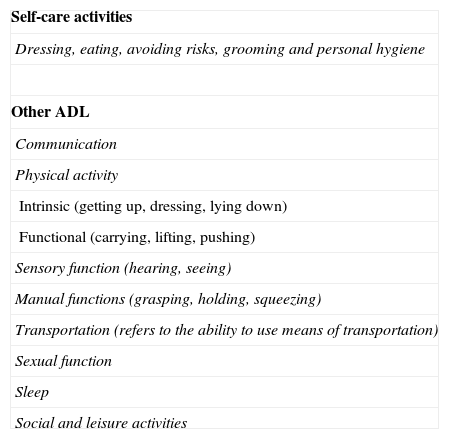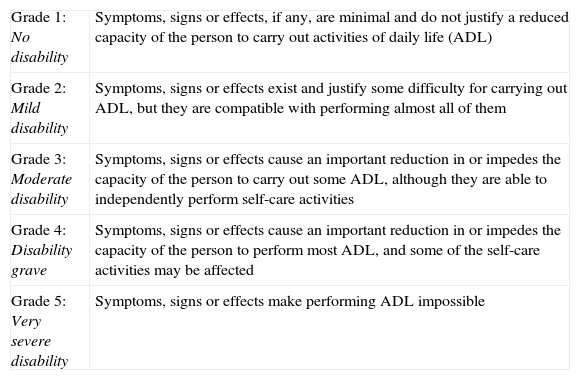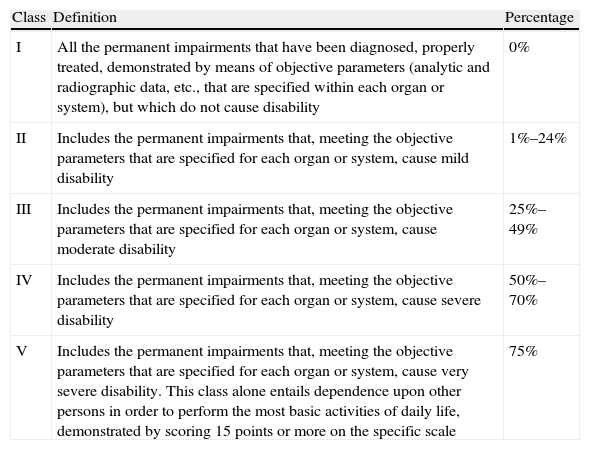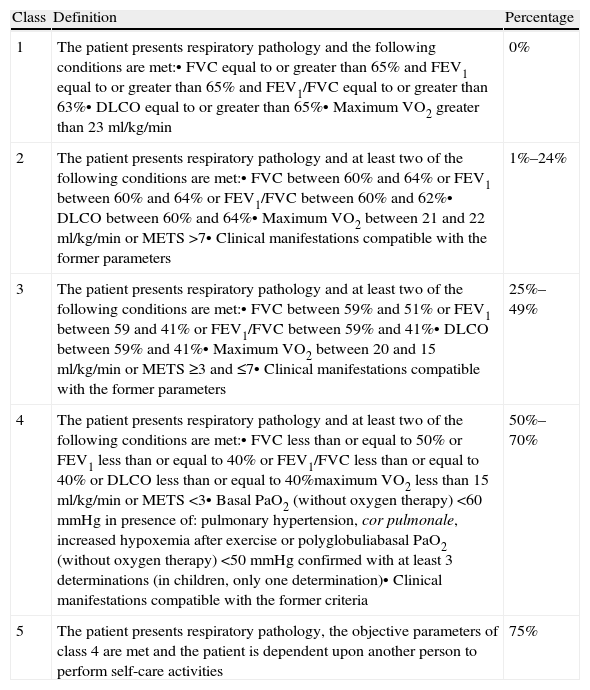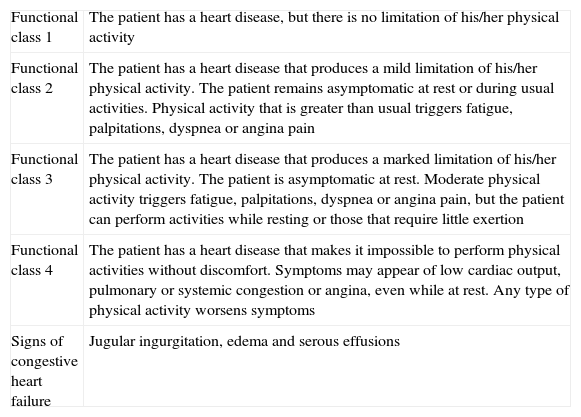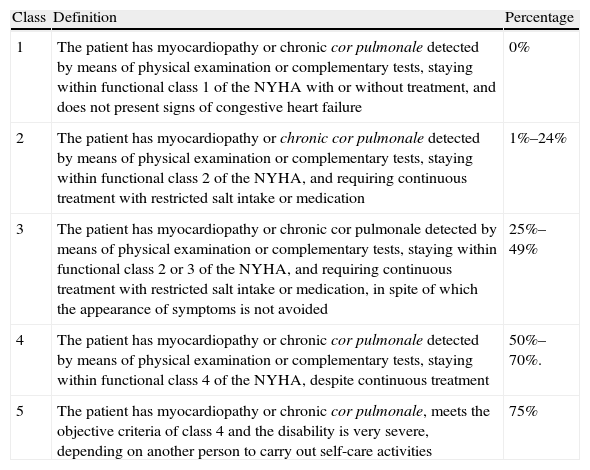The evaluation of the disabilities of patients with respiratory disease is regulated by the Spanish Ministry of Labor and Social Security, as are disabilities of any other type. We believe, however that in respiratory pathologies this evaluation is especially complicated because, as they are chronic processes, they inter-relate with other systems. Furthermore, they tend to have occasional exacerbations; therefore, normal periods may alternate with other periods of important functional limitations.
The present document arises from the desire of SEPAR to update this topic and to respond to the requests of respiratory disease patient associations who have asked us to do so. In this paper, we analyze the current situation of work disability legislation as well as the determination of degrees and percentages, including the current criteria for assigning disabilities due to respiratory tract deficiencies. Lastly, we propose work guidelines that would improve the existing scenario and outline this evaluation for specific pathologies.
La valoración de la discapacidad en los pacientes con enfermedades respiratorias está regulada por el Ministerio de Trabajo y Asuntos Sociales, al igual que las discapacidades de cualquier otro sistema; sin embargo, creemos que su evaluación es especialmente complicada, ya que al tratarse de procesos crónicos, interrelacionan con otros sistemas y además en ocasiones cursan en brotes, por lo que pueden alternar períodos de normalidad con otros de limitación funcional importante.
El presente documento tiene su origen en la voluntad de la SEPAR de actualizar el tema y de dar respuesta a la solicitud de las asociaciones de pacientes con enfermedades respiratorias que así nos lo requirieron. En el mismo efectuamos un análisis de la situación actual, tanto de la legislación vigente en materia de incapacidad laboral, como de la determinación de los grados y porcentaje de discapacidad, así como de los criterios actualmente vigentes para la asignación de discapacidad atribuible a deficiencias del aparato respiratorio. Por último, se proponen unas líneas de trabajo que permitirían mejorar el escenario existente y delimitar esta valoración para patologías concretas.
In Spain, the assessment of disability in patients with respiratory diseases is regulated by the Spanish Ministry of Labor and Social Affairs, just as disabilities of any other type. However, we believe that their evaluation is especially complicated as they are chronic processes that are interrelated with other systems and occasionally run their course with exacerbations, meaning that periods of normality may alternate with other periods of important functional limitation. On the other hand, specialists themselves are searching for other methods of respiratory disease evaluation that would involve a more multidisciplinary approach and consider the patient as a whole.1
The General Law for Social Security establishes the situations that are contemplated, disability allowances and requirements for claiming them, analyzing the situation of invalidity from two perspectives: one is related with the reduced capability to perform a specific job (work disability), and the other, with the permanent restrictions for performing activities of daily life (ADL). This is expressed with the term “disability”, which, depending on its intensity and social circumstances (family setting, occupational situation, level of education, etc.) leads to the attribution of a certain degree of disability, according to which allowances are granted regardless of previous work history. It may be said that the legal qualification of disability is the official document confirming that an individual requires more assistance than most other people. The rights that the individual is granted depend on the percentage assigned, and may include family allowances, pensions and fiscal benefits.
This present document stems from the desire of SEPAR to update the information on the topic of disability and respond to the requests of respiratory disease patient associations asking us to do so. We also analyze the present situation, both of the current legislation for matters of work disability, as well as the determination of the degrees and percentages of disability and the current criteria for assigning disability attributable to respiratory tract disorders. Last of all, we propose lines of work that would allow for improvement of the current scenario and outline this assessment for specific pathologies.
Analysis of the Situation: How Is Disability Currently Assessed in Respiratory Patients?One of the most common applications for the evaluation of respiratory diseases consists of the assessment of work disability.2 This process, which should be done by a pulmonologist, requires the previous diagnosis of a respiratory disease and the prescription and compliance with optimal treatment. Once these requirements are met, the assessment of work disability consists of successive processes3:
- •
Evaluation of the degree of deterioration. This is done by measuring how the respiratory disease affects the lung function while at rest. To do so, it is usually necessary to perform spirometry, carbon monoxide diffusion capacity and arterial blood gas tests.
- •
Evaluation of the disability. This step includes determining the degree of functional limitation (to exercise) that the disease produces. It is necessary to do a cardiorespiratory exercise test and determine peak oxygen consumption.
- •
Definition of the handicap. This last step, which is usually done by labor inspection services, establishes whether the functional limitation that the patient presents stops him/her from carrying out occupational activities. A patient with a certain degree of disability is not able to do any work requiring a high level of energy (unloading a truck, for instance) but is able to do less physically demanding jobs (office work, for example).
The pertinent legislation in this area is included in the Royal Decree4 published in January 2000. It establishes the criteria for determining the degree of disability for each system of the organism. Within the occupational assessment, what pulmonologists are usually requested to do is to determine permanent disability.
What Is a Permanent Disability?Permanent disability is a continuous health alteration that impedes or limits an individual to carry out a professional activity.
A worker is considered to be in a situation of permanent disability when, after having been administered a prescribed treatment and having been medically discharged, he/she presents severe anatomical or functional affectation that is susceptible to objective determination and foreseeably definitive, which reduce or impede his/her ability to work.
Who Declares Permanent Disability?The declaration of permanent disability is the responsibility of the Provincial Committee of the Spanish National Institute of Social Security through the so-called Disability Assessment Teams (Equipos de Valoración de Incapacidades).
Degrees of Permanent DisabilityAll the degrees of disability require a previous period of contribution, except if the disability is due to a work-related accident or to an occupational disease, in which case a period of contribution is not required.
Permanent disability is defined as being within one of the following degrees.
Partial Permanent Disability for the Usual ProfessionWithout reaching a total degree of disability, this causes a worker a reduction of no less than 33% in his/her usual profession, without impeding doing basic tasks of the occupation.
Total Permanent Disability for the Usual ProfessionThis impedes the worker to do either all the basic tasks of his/her usual profession, but he/she is able to carry out another occupation.
Complete Permanent Disability for Any Type of WorkThis type completely impedes the worker from working in any profession or job.
Major DisabilityThis is defined as the situation of a worker affected by permanent disability and who, as a result of anatomical or functional losses, requires assistance from another person in order to perform the most basic tasks of everyday life (getting dressed, getting around, eating, etc.).
International Classification of Impairments, Disabilities, and Handicaps (ICIDH)5,6In 1976, the WHO published the first International Classification of Impairments, Disabilities, and Handicaps (ICIDH), which has later been revised. The last revision is from the year 2000, with a Spanish translation being published in 2001.7 The aim of the ICIDH was to complement the International Statistical Classification of Diseases and Related Health Problems (commonly known as the ICD) to be able to establish a catalog of the consequences of the disease beyond the mere recompilation of what their causes are.
The ICIDH considers the following terms:
- •
Impairment refers to abnormalities of the body structure and appearance, as well as that of the function of an organ or system, whatever the cause, although initially impairments represent disorders at the organ level. The ICIDH, in the context of health experience, has defined it as “any loss or abnormality of psychological, physiological or anatomical structure or function”.
- •
Disability reflects the consequence of the impairment from the standpoint of functional performance and activity of the individual; disability therefore represents disabilities at the level of the individual. The ICIDH, in the context of health experience, has defined disability as “any restriction or lack (resulting from an impairment) of ability to perform an activity in the manner or within the range considered normal for a human being.”
- •
Handicap refers to the disadvantages experienced by the individual as a consequence of impairments and disabilities. Thus, handicap reflects an interaction and adaptation of the individual to his/her environment. The ICIDH, in the context of health experience, has defined it as “disadvantage for a given individual, resulting from impairment or a disability that limits or prevents the fulfillment of a role that is normal (depending on age, sex, and social and cultural factors) for that individual.”
With these definitions, it can be seen that the objective of the evaluation is to consider the individual within his/her personal and social situation.
Determining Disability Caused by Permanent ImpairmentsThe Spanish Ministry of Employment and Social Affairs (Ministerio de Trabajo y Asuntos Sociales), through the General Secretary of Social Affairs and the Institute for Seniors and Social Services (IMSERSO), published guidelines in the year 2000 which stipulated the procedures and determinations necessary for evaluating disabilities caused by permanent impairments. These guidelines were published in the Official State Bulletin (BOE) n. 22 of 26 January 2000/3355. There is an initial general section that is common for all the impairments, whose main points are the following:
- 1.
The pathological process that produced the impairment, be it either congenital or acquired, needs to have been previously diagnosed by the competent organisms; the therapeutic measures indicated need to have been applied and should be documented.
- 2.
The diagnosis of the disease is not an assessment criterion itself. The steps for evaluating disability that are established in the following chapters are based on the severity of the consequences of the disease, whatever it may be.
- 3.
Permanent impairments are those organic or functional alterations that are not recoverable, meaning that there is no reasonable possibility of restitution or improvement of the structure or function of the affected organ.
- 4.
Permanent impairments of the different organs or systems are evaluated, whenever possible, with objective parameters and are reflected in the corresponding chapters. However, the assessment is not based on the extent of the impairment but instead on the effect it has on the ability to perform ADL, meaning the degree of disability that the impairment has caused.
Impairments caused by diseases that run their course with exacerbations should be evaluated during intercritical periods. However, the frequency and the duration of the exacerbations are factors to keep in mind due to the interferences produced when performing ADL. In order to evaluate the consequences of this type of disease, the corresponding chapters include criteria for the frequency and duration of the acute phases.
The evaluation should respond to homogenous criteria. With this aim, the ADL as well as the degrees of disability are defined for their use by assessment teams; these are shown in Tables 1 and 2.
Activities of Daily Living (ADL).
| Self-care activities |
| Dressing, eating, avoiding risks, grooming and personal hygiene |
| Other ADL |
| Communication |
| Physical activity |
| Intrinsic (getting up, dressing, lying down) |
| Functional (carrying, lifting, pushing) |
| Sensory function (hearing, seeing) |
| Manual functions (grasping, holding, squeezing) |
| Transportation (refers to the ability to use means of transportation) |
| Sexual function |
| Sleep |
| Social and leisure activities |
ADL are activities that are common to all people.
American Medical Association, 1994 and 2001.12
Degrees of Disability.
| Grade 1: No disability | Symptoms, signs or effects, if any, are minimal and do not justify a reduced capacity of the person to carry out activities of daily life (ADL) |
| Grade 2: Mild disability | Symptoms, signs or effects exist and justify some difficulty for carrying out ADL, but they are compatible with performing almost all of them |
| Grade 3: Moderate disability | Symptoms, signs or effects cause an important reduction in or impedes the capacity of the person to carry out some ADL, although they are able to independently perform self-care activities |
| Grade 4: Disability grave | Symptoms, signs or effects cause an important reduction in or impedes the capacity of the person to perform most ADL, and some of the self-care activities may be affected |
| Grade 5: Very severe disability | Symptoms, signs or effects make performing ADL impossible |
Both the degrees of disability and the ADL described constitute reference patterns for assigning the percentage of disability. This percentage is determined in agreement with the criteria and the types that are specified for each system, as the legislation considers them separately. Five general categories are established (Table 3).
Percentage of Disability.
| Class | Definition | Percentage |
| I | All the permanent impairments that have been diagnosed, properly treated, demonstrated by means of objective parameters (analytic and radiographic data, etc., that are specified within each organ or system), but which do not cause disability | 0% |
| II | Includes the permanent impairments that, meeting the objective parameters that are specified for each organ or system, cause mild disability | 1%–24% |
| III | Includes the permanent impairments that, meeting the objective parameters that are specified for each organ or system, cause moderate disability | 25%–49% |
| IV | Includes the permanent impairments that, meeting the objective parameters that are specified for each organ or system, cause severe disability | 50%–70% |
| V | Includes the permanent impairments that, meeting the objective parameters that are specified for each organ or system, cause very severe disability. This class alone entails dependence upon other persons in order to perform the most basic activities of daily life, demonstrated by scoring 15 points or more on the specific scale | 75% |
When one person has two or more coexisting impairments— included in classes II–V —the percentages are combined by using a table of specific values (not merely a sum), as it is considered that the consequences of these impairments together can be stronger, producing greater interference in performing ADL and, therefore, a degree of disability higher than what is caused by each separately. The percentages obtained for impairments from different systems are combined, unless otherwise specified. When there are impairments that affect different organs of a same system, the criteria for determining under which circumstances the percentages should be combined are included in the corresponding chapters.
General Rules for Assessing Impairments Caused by Respiratory Tract DiseasesMost of the criteria described here have been adapted from the ATS criteria.8 We provide the criteria for assessing disabilities produced by respiratory tract impairments as considered from the standpoint of the alteration in lung function and, in most cases, quantifiable with objective tests.9
- 1.
The only respiratory disease patients who will be assessed are those who have chronic diseases considered to be non-recoverable in function, with a clinical course of no less than 6 months since the diagnosis and start of treatment.
- 2.
The assessment of the impairment is based on the result of objective lung function tests (spirometry, carbon monoxide diffusion capacity and exercise capacity), complemented with clinical criteria. Transitory functional alterations that are either spontaneously reversible or reversible with treatment should not be considered.
- 3.
In clinical stages that, as a consequence of exacerbative phases, may experience an increase in respiratory dysfunction, a new evaluation should not be repeated until the situation has stabilized.
When the respiratory disease runs its course with exacerbations, the evaluation of the disability that may be produced is done during intercritical periods. For the evaluation of these situations, a criterion of temporality has been introduced according to the frequency and duration of the episodes, and said episodes should be documented medically.
- 4.
The rules and criteria for the assessment of persons who have diseases that, due to their characteristics, require being considered differently than other respiratory tract pathologies are contemplated in the section “Criteria for the assessment of specific situations”.
- 5.
If the respiratory affectation is part of a pathologic entity with manifestations in other organs and systems, the disability percentages corresponding to all the affected parts are combined.
Table 4 demonstrates the criteria for assigning the percentage of disability depending on respiratory function limitations.
Criteria for the Assignation of Disability Percentages for Respiratory Tract Impairments.
| Class | Definition | Percentage |
| 1 | The patient presents respiratory pathology and the following conditions are met:• FVC equal to or greater than 65% and FEV1 equal to or greater than 65% and FEV1/FVC equal to or greater than 63%• DLCO equal to or greater than 65%• Maximum VO2 greater than 23ml/kg/min | 0% |
| 2 | The patient presents respiratory pathology and at least two of the following conditions are met:• FVC between 60% and 64% or FEV1 between 60% and 64% or FEV1/FVC between 60% and 62%• DLCO between 60% and 64%• Maximum VO2 between 21 and 22ml/kg/min or METS >7• Clinical manifestations compatible with the former parameters | 1%–24% |
| 3 | The patient presents respiratory pathology and at least two of the following conditions are met:• FVC between 59% and 51% or FEV1 between 59 and 41% or FEV1/FVC between 59% and 41%• DLCO between 59% and 41%• Maximum VO2 between 20 and 15ml/kg/min or METS ≥3 and ≤7• Clinical manifestations compatible with the former parameters | 25%–49% |
| 4 | The patient presents respiratory pathology and at least two of the following conditions are met:• FVC less than or equal to 50% or FEV1 less than or equal to 40% or FEV1/FVC less than or equal to 40% or DLCO less than or equal to 40%maximum VO2 less than 15ml/kg/min or METS <3• Basal PaO2 (without oxygen therapy) <60mmHg in presence of: pulmonary hypertension, cor pulmonale, increased hypoxemia after exercise or polyglobuliabasal PaO2 (without oxygen therapy) <50mmHg confirmed with at least 3 determinations (in children, only one determination)• Clinical manifestations compatible with the former criteria | 50%–70% |
| 5 | The patient presents respiratory pathology, the objective parameters of class 4 are met and the patient is dependent upon another person to perform self-care activities | 75% |
The assessment of ventilatory function in situations of chronic asthma should be done after the administration of bronchodilators, especially beta agonists.
In the case of pneumonitis due to hypersensitivity, the assessment should be done once the trigger factor has been eliminated, if possible.
When there are frequent episodes of exacerbation, the following complementary criteria should be taken into account:
- •
Patients with intercrisis baseline situation, including class 1 or 2, who suffer exacerbation episodes every 2 months or 6 episodes on average per year requiring hospital treatment of at least 24h, should be assessed as having a disability percentage of 33%.
- •
When the patient meets the minimum criteria for frequency and his/her baseline situation is class 3, he/she should be assigned a disability percentage of at least 60%.
In cases with suspicion of exercise-induced asthma, it is essential to order physical tolerance tests to confirm the diagnosis.
Given the fact that asthma that initiates in childhood and youth tends to remit with age, periodic revisions should be programmed within a maximum of 5 years.
BronchiectasisAs a complication of bronchiectasis, patients who present a moderate degree of disability and bronchopulmonary infections with a periodicity equal to or greater than one every two months or an average of 6 a year should be included in class 3 (25%–49%).
If the patient presents the same frequency of pneumonia and his/her degree of disability is severe, he/she should be included in class 4 (50%–70%).
These situations should be medically documented, requiring one year of a maintained clinical situation in order to order the assessment.
Cystic FibrosisThe percentage of disability assigned due to the respiratory impairment is combined with the percentage corresponding with the affectation of other systems: gastrointestinal, endocrinological, bone metabolism diseases, etc.
In cases of repeated pneumonia, the same criteria are applied as in the case of bronchiectasis.
Sleep Apnea SyndromeSleep apnea syndrome is defined as an intermittent detention of the airflow through the mouth and nose during sleep that lasts more than 10s.
The definitive diagnosis is done with polysomnography or, in case this is not available, by means of nocturnal oximetry that demonstrates arterial O2 desaturations during apneas.
The assessment is done depending on the degree of baseline respiratory failure, combining with this the disability caused by the affectation of other systems, once the therapeutic measurements are applied.
Alterations in Pulmonary Circulation: Pulmonary Thromboembolism, Pulmonary Arterial HypertensionAlterations in pulmonary circulation can cause respiratory dysfunction. The percentage of disability caused by this dysfunction should be combined with that caused by right heart failure if patients present it.
Extrapulmonary Diseases With Deterioration of Respiratory FunctionPleural diseases, thoracic deformities and neuromuscular disease can run their course with restrictive ventilator alteration. The percentage of disability produced by this impairment should be combined with the percentage corresponding to other systems.
Lung TransplantationIf the patient has had a previous evaluation, this is valid for the first 6 post-transplant months.
After this period, the patient should be re-assessed. The patient should be assigned the percentage of disability caused by the residual respiratory impairment that he/she presents.
Disability Caused by Chronic cor pulmonaleThe percentage of disability caused by chronic cor pulmonale will be combined with that derived from the associated respiratory disease. Due to the fact that respiratory diseases are the most frequent cause of chronic cor pulmonale, the dyspnea should not be considered a manifestation of this pathology. Only the presence of clinical data for congestive heart failure and the electrocardiographic, radiological or ultrasound evidence of growth or dilation of the right ventricle should be contemplated.
Table 5 enumerates the types of functional class attributable to heart failure, and Table 6 shows the criteria for calculating the percentage of disability due to chronic cor pulmonale.
Clinical Assessment of Heart Failure.
| Functional class 1 | The patient has a heart disease, but there is no limitation of his/her physical activity |
| Functional class 2 | The patient has a heart disease that produces a mild limitation of his/her physical activity. The patient remains asymptomatic at rest or during usual activities. Physical activity that is greater than usual triggers fatigue, palpitations, dyspnea or angina pain |
| Functional class 3 | The patient has a heart disease that produces a marked limitation of his/her physical activity. The patient is asymptomatic at rest. Moderate physical activity triggers fatigue, palpitations, dyspnea or angina pain, but the patient can perform activities while resting or those that require little exertion |
| Functional class 4 | The patient has a heart disease that makes it impossible to perform physical activities without discomfort. Symptoms may appear of low cardiac output, pulmonary or systemic congestion or angina, even while at rest. Any type of physical activity worsens symptoms |
| Signs of congestive heart failure | Jugular ingurgitation, edema and serous effusions |
Criteria for Assigning the Percentage of Disability for Chronic cor pulmonale.
| Class | Definition | Percentage |
| 1 | The patient has myocardiopathy or chronic cor pulmonale detected by means of physical examination or complementary tests, staying within functional class 1 of the NYHA with or without treatment, and does not present signs of congestive heart failure | 0% |
| 2 | The patient has myocardiopathy or chronic cor pulmonale detected by means of physical examination or complementary tests, staying within functional class 2 of the NYHA, and requiring continuous treatment with restricted salt intake or medication | 1%–24% |
| 3 | The patient has myocardiopathy or chronic cor pulmonale detected by means of physical examination or complementary tests, staying within functional class 2 or 3 of the NYHA, and requiring continuous treatment with restricted salt intake or medication, in spite of which the appearance of symptoms is not avoided | 25%–49% |
| 4 | The patient has myocardiopathy or chronic cor pulmonale detected by means of physical examination or complementary tests, staying within functional class 4 of the NYHA, despite continuous treatment | 50%–70%. |
| 5 | The patient has myocardiopathy or chronic cor pulmonale, meets the objective criteria of class 4 and the disability is very severe, depending on another person to carry out self-care activities | 75% |
- 1.
The recommendations of the Ministry of Labor are aimed at making an overall assessment of patients, even considering the additional effect of alterations in different systems (digestive, muscular-skeletal, etc.).
- 2.
What is most striking is the lack of knowledge among pulmonologists of the legislation and the way in which patients should be assessed as a whole. Therefore, one of the tasks that SEPAR should assume is to communicate the general content of this legislation among its members, and especially the legislation having to do with the respiratory tract.
- 3.
The assessment of different diseases is based on strict functional parameters measured by spirometry, whose cut-point has not been validated in any later study and comes from an old publication from the 1960s.11 The determination of static lung volumes is not contemplated.
- 4.
Within the section of the specific situations, in some cases, such as arterial hypertension, the recommendations are vague and should be extended with the consensus for evaluation in pulmonary hypertension, which would include: respiratory function testing, grading scales for functional state and exertion tests.12
- 5.
The patient assessment does not include standard quality-of-life questionnaires, despite the fact that in recent years these quality measures have been used in patients with respiratory diseases given the evidence that functional testing alone does not reflect the ability of a patient to carry out their work or their daily activities. Most respiratory function tests are done at rest.
- 6.
The exertion tests that are contemplated are oxygen uptake and metabolic equivalents (MET), which require infrastructure for them to be performed as well as a patient who is able to perform them; nevertheless, there is a growing tendency towards using the 6-min walk test as a substitute that practically all patients can perform.
- 7.
There is no specific consideration for COPD patients. It is a mistake not to consider COPD with multisystem parameters that are provided by new tools like the BODE index.
- 8.
In the case of interstitial diseases, severe functional situations are not adequately assessed because radiographic parameters, static lung volume determination and desaturation upon exertion are not contemplated.
- 9.
In the case of sleep apnea syndrome, the diagnosis is contemplated from the standpoint of polysomnography and nocturnal oximetry, without considering respiratory polygraph, and its consequences are only evaluated in terms of respiratory failure, without considering cardiovascular repercussions or residual, basal or daytime sleepiness after proper treatment.
The actions that SEPAR may propose to include the following:
- 1.
Diffusion among its members the legal criteria for disability as well as the way to assess them with initiatives such as workshops or courses to teach how to do functional assessments.
- 2.
Propose the inclusion of a series of determinations that are not currently contemplated, which in interstitial diseases can be representative of the degree of affectation, such as imaging techniques, pulse-oximetry during exercise or the determination of static lung volumes.
- 3.
Validate the spirometry cut-points with other global (multidimensional) parameters that are more representative and have a greater relationship with quality of life and mortality, probably by means of multicenter studies or data analyses from large cohorts of patients with COPD that are being carried out by the different SEPAR workgroups (COPD Area, etc.).
- 4.
Include radiographic parameters that can be useful in cases of interstitial disease or emphysema that are not currently contemplated.
- 5.
Attempt to define for each specific disease the best parameters that reflect the deterioration of a patient, separating COPD from the general group.
Please cite this article as: Ruiz Manzano J, et al. Valoración de la discapacidad en los enfermos respiratorios. Arch Bronconeumol. 2012;48:290–5.


